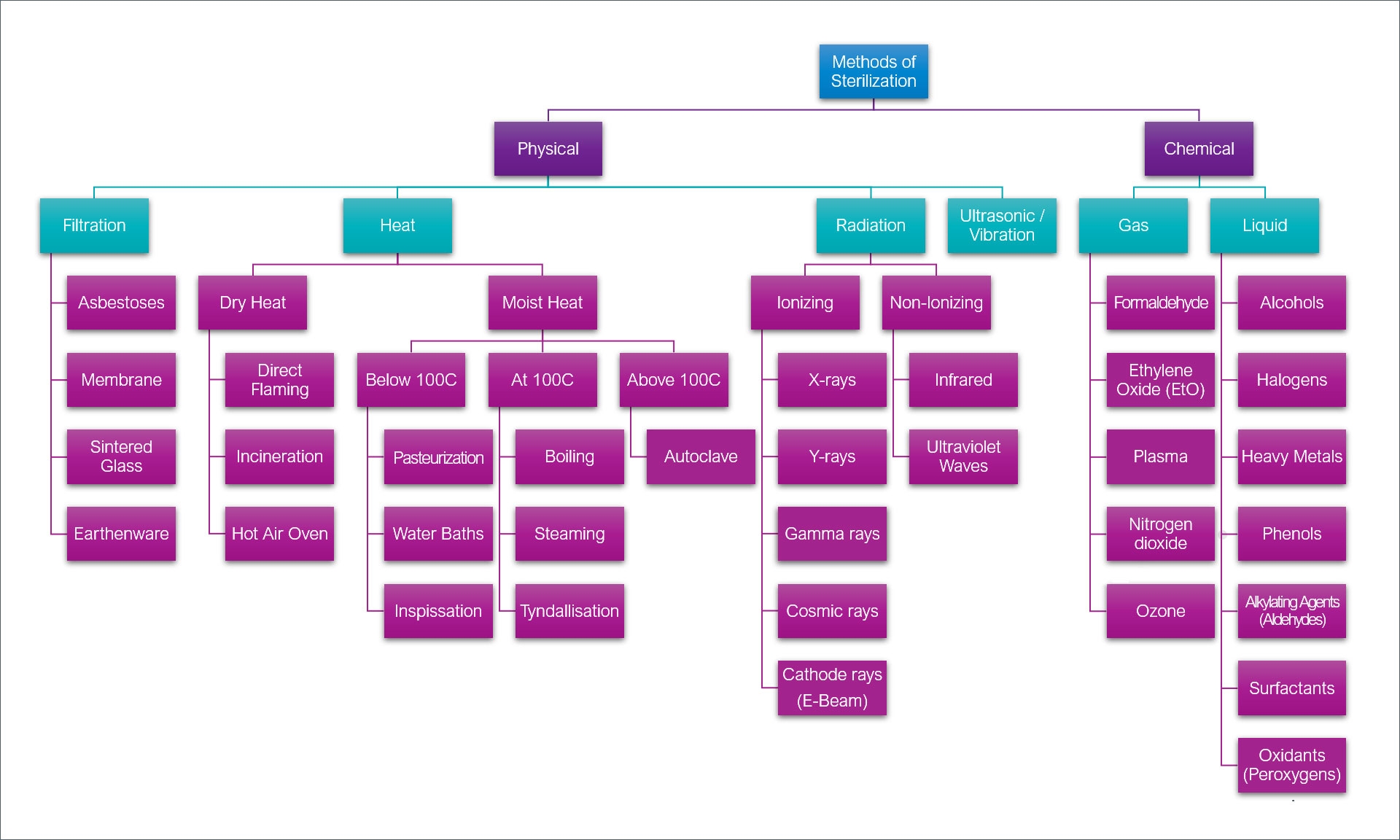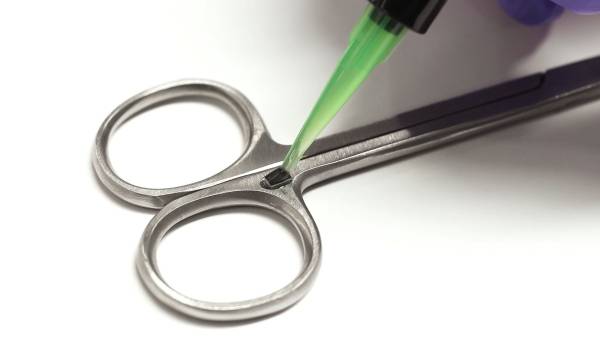Autoklavenbeständige Klebstoffe könnten die Lösung sein
Hohe Hitze, Feuchtigkeit, Chemikalien und andere Umweltfaktoren können medizinische Instrumente wie Endoskope, chirurgische Instrumente, zahnärztliche Geräte, medizinische Geräte für den allgemeinen Gebrauch und Gehäusebaugruppen sowie Sensoren und RFID-Tags, die an medizinischen Instrumenten angebracht sind, vor Probleme stellen. Die Materialien, die die Komponenten solcher Geräte verbinden, beschichten und einkapseln, können durch diese Kräfte negativ beeinflusst werden, was möglicherweise zu Geräteausfällen, verlorenen oder verlegten Instrumenten oder zu Verletzungen eines Patienten führen kann. Deshalb ist es wichtig, dass die zum Schutz und zur Verbindung der Teile verwendeten Produkte einer Vielzahl von Belastungen standhalten können.
Neben den strengen physikalischen Tests, Normen und Zulassungen, die Formulierungen für medizinische Geräte unterzogen werden, einschließlich ISO 10993, müssen viele auch wiederholten Sterilisationszyklen standhalten.
In der Medizingeräteindustrie werden zwei Sterilisationskategorien verwendet: physikalisch und chemisch. Zu den physikalischen Sterilisationsmethoden zählen Filtration, Hitze, Strahlung und Ultraschall/Vibration, während bei der chemischen Sterilisation ein Gas- oder Flüssigkeitsprozess erforderlich ist. Es gibt eine große Auswahl an Techniken, die in diese Hauptklassen fallen, wie etwa EtO, Gammastrahlen, Elektronenstrahlen, Kathodenstrahlen und Oxidationsmittel sowie Autoklaven und STERRAD™ Wasserstoffperoxid-Plasma.
Die Arten von physikalischen und chemischen Sterilisationsmethoden, die in der medizinischen Branche üblicherweise verwendet werden.
Die Anwendung vieler dieser Verfahren hat Vor- und Nachteile. Zu den positiven Eigenschaften und Ergebnissen, die von der gewählten Methode abhängen, gehören eine hohe Durchdringungsfähigkeit, eine sehr schnelle Wirkung gegen Mikroorganismen und die Beseitigung potenzieller Rückstände. Zu den negativen Faktoren können lange Sterilisationszyklen, Entflammbarkeit, die Verwendung gefährlicher Materialien oder Chemikalien, die Vergilbung von Polymeren und die Korrosion verschiedener Metallsubstrate gehören.
Welche Sterilisationsart anzuwenden ist, hängt vom Endprodukt, seiner Funktion, den Substratkomponenten sowie den Drücken und Umgebungen ab, denen das Gerät ausgesetzt wird. Autoklav (Dampf) und Wasserstoffperoxid-Gasplasma (HPGP) sind zwei Methoden, die in der Medizingeräteindustrie häufig eingesetzt werden.
Beim Autoklavieren werden Mikroorganismen und Bakterien mit Dampf unter hohem Druck von Instrumenten entfernt, die die Oberflächen von Substraten verunreinigen und dadurch abtöten und unwirksam machen können. Dabei sind jedoch einige wichtige Punkte zu beachten. Viele Metalle können nach wiederholter Dampfeinwirkung korrodieren oder rosten. Einige Kunststoffe können ihre strukturelle Integrität verlieren, empfindlich auf erhöhte Hitze reagieren, anfällig für die Migration von Weichmachern auf die Substratoberfläche sein oder bei Kontakt mit Wasser negativ reagieren oder sich zersetzen.
Die Sterilisation durch Autoklavieren ist auf bestimmte Anwendungen beschränkt. Viele Klebstoffe für medizinische Geräte halten beispielsweise dem Autoklavieren aufgrund der hohen Temperaturen, Feuchtigkeit und des Drucks, die bei diesem Prozess auftreten, nur schwer stand. Aufgrund dieser Faktoren kann es zu einer geschwächten Klebeverbindung kommen, die versagt. Alternativen zur Dampfsterilisation für hitze- und feuchtigkeitsempfindliche Instrumente und Geräte werden immer häufiger in Betracht gezogen, obwohl das Autoklavieren für Krankenhäuser, Labore, Forschungseinrichtungen usw. weiterhin eine der zugänglichsten Optionen darstellt.
Die STERRAD™-Sterilisation ist eine ideale Methode für hitze- und feuchtigkeitsempfindliche Geräte, da die Temperaturen während der Verarbeitung ca. 56 °C (133 °F) nicht überschreiten. Eine Lösung aus Wasserstoffperoxid und Wasser wird in den Sterilisator geleitet und dann in der Kammer verdampft. Die Lösung umgibt die Geräte, interagiert mit ihnen und erzeugt eine biozide Umgebung, die Mikroorganismen inaktiviert. Ein starkes elektrisches Feld wird an die Kammer angelegt und erzeugt ein Wasserstoffperoxid-Gasplasma, das Wasserstoffperoxidmoleküle in angeregte Spezies aufspaltet. Sobald das elektrische Feld abgeschaltet wird, rekombinieren die angeregten Spezies, wodurch das Wasserstoffperoxid in Wasser und Sauerstoff umgewandelt wird. Dadurch wird sichergestellt, dass die Instrumente schnell sterilisiert werden, ohne dass giftige Rückstände verbleiben.
Viele Arten medizinischer Endoskope und Geräte erfordern wiederholte Sterilisationszyklen oder mehrere Autoklaviervorgänge oder alternative Sterilisationsmethoden wie die Wasserstoffperoxid-Plasma-Sterilisation.
Beispielliste von SCOPES, die mehrere Sterilisationszyklen erfordern
Arthroskope
Bronchoskope
Koloskope
Duodenoskope
Endoskope
Ösophagoskope
Laparoskopische Instrumente
Beispielliste zusätzlicher Geräte
Zahnärztliche Werkzeuge/Ausrüstung
Ophthalmische Werkzeuge/Ausrüstung
Chirurgische Werkzeuge/Instrumente
Zubehör für Endoskopbiopsien (normalerweise Werkzeuge, z. B. Zangen)
Spülsysteme (z. B. wiederverwendbare Spülkanülen)
Eine wichtige Anwendung, die in der Medizingerätebranche in den Vordergrund gerückt ist, ist die Verwendung von Identifikationsetiketten oder RFIDs (Radio Frequency Identification) auf chirurgischen Werkzeugen, Instrumenten und Verpackungen wie Fläschchen. RFIDs auf medizinischen Geräten helfen bei der Aufrechterhaltung genauer Lagerbestände und helfen dabei, diese während der Behandlung im Auge zu behalten. Weitere Einsatzbereiche und typische Anwendungen sind:
Krankenhäuser, Kliniken und Pflegekräfte:
- „Einchecken / Auschecken“ der Vielzahl an Geräten und Werkzeugen, die für Eingriffe und Operationen benötigt werden
− Angetrieben durch Fälle, in denen nach Operationen Werkzeuge oder Zubehör im Körper zurückgelassen wurden - Überprüfen Sie den Sterilisationsstatus vor der Verwendung
- Bestandsdetails und -daten verbessern
Andere Gesundheitsbereiche:
- Arzneimittelverfolgung, um sicherzustellen, dass die richtige Dosierung gewährleistet ist und die richtigen Lagerbedingungen eingehalten werden
- Verfolgung von Blut-/biologischen Proben hinsichtlich Lagerung, Verwendungszeiten und automatischer Verfolgung, um eine ordnungsgemäße Handhabung sicherzustellen
- Vermögenswerte wie chirurgische Instrumente, Zahnarzt- und Krankenhausausrüstung, Patienten und andere
RFIDs, die an häufig verwendeten chirurgischen Instrumenten angebracht sind, und die zu ihrer Befestigung verwendeten Materialien müssen mehrere Sterilisationsvorgänge bestehen und diese Prozesse über Hunderte von Zyklen hinweg erfolgreich überstehen.
Auftragen eines Vergussmasse auf einen RFID-Chip, der an einer medizinischen Pinzette befestigt ist.
Obwohl es auf dem Markt formulierte Ein- und Zweikomponenten-Epoxide zum Klebung, Beschichtung und Vergießend gibt medizinische Geräte und RFIDs, diese Produkte sind möglicherweise nicht die beste Wahl. Im Vergleich zu lichthärtenden Materialien haben Epoxidharze zahlreiche Nachteile, wie spezielle Mischsysteme, lange Aushärtezeiten von bis zu 60 Minuten, kurze Topfzeit, die Verwendung von Wärmehärtungsöfen (in manchen Fällen), geringere Flexibilität und Schlagfestigkeit und die Notwendigkeit von Spülzyklen, die zu gefährlichen Abfällen führen können. Einkomponentige lichthärtende aushärtbare Klebstoffe stellen eine Alternative zu diesen Lösungen dar, indem sie den Herstellern schnelle Aushärtezeiten von 1 bis 30 Sekunden, kein Mischen oder Spülen, eine Reihe von Qualitäten von starr bis flexibel, RoHS-konform und ohne Lösungsmittelzusatz für einfachere Handhabung und Entsorgung bieten. Die positiven Vorteile lichthärtender Materialien können dazu beitragen, die Fertigungseffizienz zu verbessern, Kosten zu senken und den Durchsatz zu erhöhen.
Um den Bedarf an einem Produkt zu decken, das häufige Sterilisationsvorgänge übersteht, wurde ein neues, vielseitiges UV/LED- aushärtbarer Klebstoff wurde entwickelt, das eine extrem geringe Wasseraufnahme (0,5 %) aufweist und über 100 Zyklen von Autoklav- und Plasmaprozessen standhält. Dieses Material wird als Beschichtung oder Vergussmasse für Gehäusebaugruppen, medizinische Instrumente zum einmaligen oder mehrfachen Gebrauch sowie verschiedene medizinische Endoskope und zahnärztliche Geräte empfohlen. Es eignet sich besonders zum Vergießend von RFID-Chips, Sensoren und anderen elektronischen Komponenten, die sich auf medizinischen Geräten, Werkzeugen und Fläschchen befinden, bei denen das Eindringen von Feuchtigkeit ein Problem darstellen kann. Zu den verklebbare Substrate gehören Edelstahl, Aluminium, Glas, PP/PE und Leiterplatten.
Der Klebstoff wurde einer Reihe von Leistungstests unterzogen, darunter beschleunigte Alterung und Sterilisation, Bewertung der Wasseraufnahme, Prüfung der elektrischen Eigenschaften und Prüfung der Wasserdampfdurchlässigkeit. Das Material entspricht den Zytotoxizitätsstandards ISO 10993-5 und härtet bei Einwirkung von Breitband-UV- oder 365 nm-LED-Licht in Sekunden aus.
Wenn Sie als Hersteller an der Montage und dem Schutz medizinischer Geräte und Instrumente beteiligt sind und auf der Suche nach einem Klebung, Beschichtung und Vergießend sind, das mehr als 100 Sterilisationszyklen übersteht, dann könnte dieses Produkt die Lösung für Ihren Anwendungsbereich sein.
STERRAD™ ist ein eingetragenes Warenzeichen der ASP Global Manufacturing GmbH.



